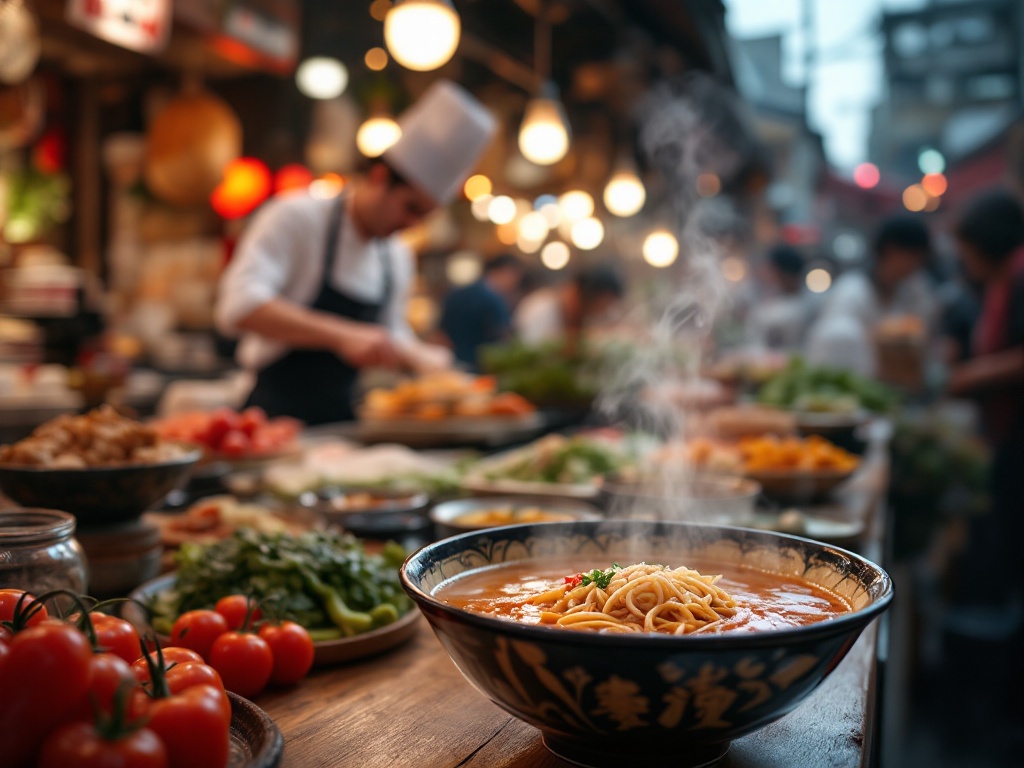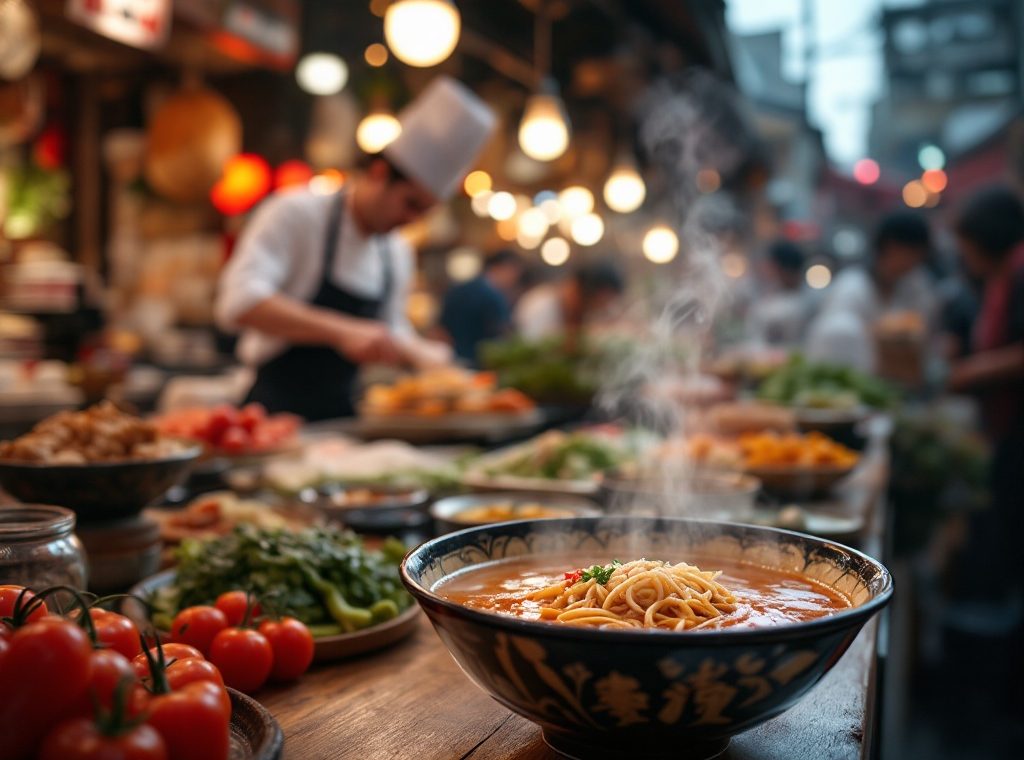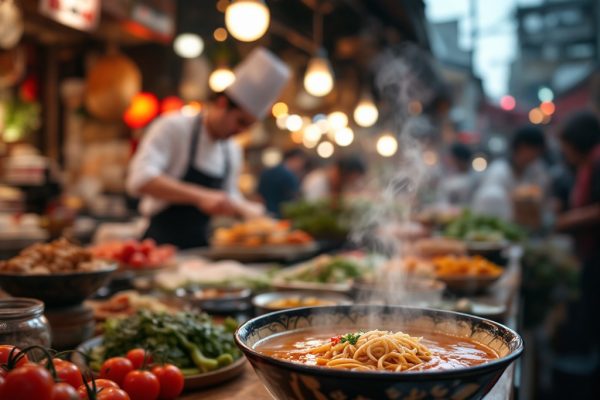Traveling to Japan: Discover the Interesting Umami Flavor
Embark on a culinary adventure to Japan, the land of umami, the savory fifth taste! Explore vibrant markets like Kyoto’s Nishiki Market and Tokyo’s Tsukiji Fish Market, savoring rich ramen, delicate sushi, and other umami-rich delights. Discover the science behind this unique flavor and deepen your understanding through cooking classes and food tours. From casual street food to Michelin-starred kaiseki dinners, unlock the secrets of umami and experience Japanese cuisine like never before. Start your delicious journey today!
Important information

- Umami, the fifth taste, is a savory flavor central to Japanese cuisine, adding depth and complexity to dishes.
- Key ingredients for umami include kombu (kelp), katsuobushi (dried bonito flakes), and dried shiitake mushrooms, often combined to make dashi, a fundamental Japanese broth.
- Kyoto and Tokyo are excellent places to explore umami, with Kyoto known for traditional kaiseki dinners and Nishiki Market, while Tokyo offers diverse ramen options and the Tsukiji Fish Market.
- Sake, a traditional Japanese beverage, enhances the umami experience with its diverse flavor profiles.
- Japanese chefs continue to innovate with umami, blending traditional ingredients with new elements to create exciting modern dishes.
Traveling to Japan: Discover the Interesting Umami Flavor
Embark on a culinary journey through Japan and unlock the savory fifth taste: umami. Kyoto and Tokyo offer incredible starting points for this adventure.
Market Exploration
Wander through vibrant local markets like Nishiki Market in Kyoto and the world-renowned Tsukiji Fish Market (outer market) in Tokyo. From tantalizing street food to traditional restaurants, your palate will be delighted.
Dining Experiences
Indulge in diverse dining experiences, from casual street food stalls to Michelin-starred establishments. Savor regional specialties like rich ramen, delicate sushi, and crispy tempura, or indulge in an elaborate multi-course kaiseki dinner for a truly luxurious umami experience.
Umami Immersion
Go beyond tasting and deepen your understanding of umami. Immerse yourself in Japanese culinary culture with a cooking class or a guided food tour. Explore the key ingredients that contribute to umami, such as kombu (kelp), katsuobushi (dried bonito flakes), and the art of fermentation.
Sake Pairing
Complete your culinary experience with a sip of sake. This traditional Japanese beverage perfectly complements the savory depth of umami.
Introduction to Umami: Japan’s Fifth Taste
Umami, a savory taste often described as meaty or brothy, joins sweet, sour, salty, and bitter as the fifth basic taste. It is particularly recognized in Japan.
Understanding Umami: The Unique Japanese Flavor
Umami, a savory sensation, stands as the fifth taste, distinct from sweet, sour, salty, and bitter. Essential to Japanese cuisine, it delivers a rich depth of flavor. This unique taste derives from glutamates, natural compounds present in numerous foods. Interacting with specialized receptors on the tongue, these compounds create umami’s distinctive character, adding a layer of complexity to Japanese dishes.
What is Umami? A Pleasant Savory Taste
Umami, a fundamental taste, is often described as savory, pleasant, or meaty—a rich, satisfying flavor. Specialized receptors on our tongues detect this taste by recognizing glutamates and nucleotides, compounds found in foods like mushrooms, ripe tomatoes, and aged cheeses. Umami adds depth and complexity, especially in Japanese cuisine, enhancing the overall dining experience.
The Science Behind Umami: How Our Taste Buds Perceive It
We perceive umami through specialized taste receptors, T1R1 and T1R3, which detect glutamate, an amino acid prevalent in protein-rich foods like meat and cheese. These receptors also interact with certain nucleotides, such as inosinate and guanylate, which amplify the umami sensation. This interaction triggers a complex signal cascade that ultimately results in our experience of this savory taste.
Key Ingredients and Sources of Umami
Umami flavor depends on three key ingredients: glutamate, inosinate, and guanylate. Glutamate is readily found in meat and kombu kelp, while inosinate is prevalent in dried bonito flakes (katsuobushi). Dried shiitake mushrooms provide guanylate. Japanese cuisine masterfully blends these elements, epitomized by dashi, a fundamental broth showcasing umami’s savory depth.
Japanese Cuisine and the Role of Umami
Japanese cuisine is renowned for its delicious umami, a savory fifth taste that gives dishes incredible depth and complexity. Umami is a defining characteristic of Washoku, Japan’s traditional cuisine and a UNESCO Intangible Cultural Heritage. Dashi broth, a staple in Japanese cooking, is rich in this unique flavor. Traditional dishes like sushi, tempura, and elaborate kaiseki dinners further showcase umami’s power.
Washoku: A UNESCO Intangible Cultural Heritage
Japanese Washoku cuisine, celebrated worldwide for its unique flavors and cooking techniques, is recognized as a UNESCO Intangible Cultural Heritage. This distinction highlights its cultural significance and emphasizes its importance as a delicious expression of Japanese culinary tradition.
The Vital Role of Dashi Broth in Japanese Cuisine
Dashi, a fundamental broth in Japanese cooking, is crafted from kombu (kelp) and katsuobushi (bonito flakes). This combination creates a rich umami base that enhances the flavor of countless dishes. These include miso soups, stews, and various sauces. It’s this essential ingredient that gives washoku (traditional Japanese cuisine) its distinctive character.
Kaiseki Dinner: A Multi-Course Umami Experience
Experience the artistry of Kaiseki, a traditional Japanese multi-course dining experience. Showcasing seasonal ingredients and the savory depth of umami, each meticulously crafted dish is a feast for the eyes. Travelers seeking an authentic culinary adventure can savor Kaiseki dinners in traditional restaurants throughout Japan. Kyoto is a particularly renowned destination for this exquisite cuisine.
Exploring Traditional Japanese Dishes: Sushi, Tempura, and More
Japanese cuisine is famous for its savory umami flavor. Several dishes highlight this unique taste sensation.
Sushi
This dish features fresh fish, a natural source of umami, making it a light and refreshing way to experience this savory taste.
Tempura
The delicate batter and dipping sauce in tempura provide a lighter yet still satisfying umami experience.
Ramen
The rich broth, often made with pork bones and seafood, creates a deeply savory umami flavor that defines this popular dish.
Miso Soup
Fermented soybean paste gives miso soup a powerful umami punch, making it a flavorful and comforting staple.
Okonomiyaki
This savory pancake incorporates various ingredients specifically chosen to enhance its umami flavor.
Takoyaki
Similar to okonomiyaki, takoyaki, or octopus balls, are packed with umami-rich ingredients, offering a delicious and savory snack.
The Art of Japanese Cooking Techniques
Fermentation plays a vital role in Japanese cuisine, particularly in creating miso and soy sauce. It stands alongside grilling and simmering as a core technique for enhancing umami. Grilling imparts a savory char to meats, while simmering ingredients in broth deepens their flavors. However, it’s fermentation that truly unlocks the most complex umami notes, especially in staples like miso and soy sauce. Umami-rich dashi, along with other broths and soups, further elevates these savory flavors, forming a cornerstone of Japanese cooking.
Fermentation Techniques: Miso, Soy Sauce, and More
Fermentation is essential to Japanese cuisine, producing umami-rich ingredients like miso and soy sauce. Miso, a fermented soybean paste, comes in various types, each with a unique umami flavor. Soy sauce, a staple made from fermented soybeans, wheat, and salt, delivers a powerful umami taste. Other fermented ingredients, such as sake, mirin, and tsukemono (pickles), further deepen the flavor of Japanese dishes. These fermentation methods not only create complex flavor enhancers but also represent a cornerstone of Japanese culinary heritage.
Enhancing Flavors with Umami-Rich Broths and Soups
Umami, a savory depth, is essential to Japanese cuisine, particularly in broths and soups. A prime example is dashi, a fundamental Japanese broth typically made from kombu (kelp) and katsuobushi (dried bonito flakes). This umami-rich foundation flavors iconic dishes like miso soup, ramen, and udon. Beyond dashi, simmered broths made with meat, seafood, or vegetables also contribute significant savory notes to soups and stews.
Experiencing Umami in Japan
Embark on a culinary journey through Japan, a land brimming with umami. Begin your adventure in the cultural hubs of Kyoto and Tokyo.
Kyoto
Kyoto’s Nishiki Market is a vibrant tapestry of flavors, perfect for sampling classic dishes like ramen and sushi. Don’t miss the regional specialties, often hiding unexpected umami treasures.
Tokyo
Tokyo’s Tsukiji Fish Market offers an equally captivating experience. It showcases an array of umami-rich ingredients, perfect for sampling classic dishes like ramen and sushi.
Savor the distinct taste of sake, and for a truly unforgettable experience, indulge in a meal at a Michelin-starred restaurant. Japan’s umami awaits your discovery.
Exploring Kyoto and Tokyo: The Heart of Japanese Culinary Traditions
Kyoto, famous for its Kaiseki cuisine, offers elaborate multi-course meals. These meals showcase seasonal ingredients and subtle umami flavors.
Tokyo, a vibrant metropolis, boasts a diverse culinary landscape. From Michelin-starred establishments to bustling street food stalls, Tokyo highlights the savory essence of umami in both traditional and innovative dishes.
These two cities offer distinct yet equally compelling culinary journeys into the rich tapestry of Japanese umami.
Culinary Adventures in Kyoto and Tokyo
Kyoto, renowned for its traditional kaiseki dinners, offers a very different culinary experience than Tokyo, a ramen lover’s paradise. While both cities boast an array of Michelin-starred restaurants, they also offer vibrant markets brimming with umami-rich ingredients. Kyoto’s Nishiki Market and Tokyo’s Tsukiji Fish Market are prime examples. Further enriching the culinary journey, street food stalls and local eateries provide a delicious taste of each city’s unique character.
Kyoto
Experience traditional kaiseki dinners.
Explore the vibrant Nishiki Market.
Enjoy the unique character of local eateries and street food.
Tokyo
Indulge in a ramen lover’s paradise.
Discover the bustling Tsukiji Fish Market.
Savor the diverse flavors of street food and local restaurants.
Visiting the Nishiki Market and Tsukiji Fish Market
Kyoto’s Nishiki Market, known as “Kyoto’s Kitchen,” overflows with fresh produce, seafood, and pickles, the very building blocks of the region’s savory umami flavors. The market vividly demonstrates the importance of fresh, high-quality ingredients in Japanese cuisine and its distinctive umami taste.
Similarly, Tokyo’s bustling Tsukiji Outer Market offers a vast array of seafood, dried goods, and tempting street food, many incorporating ingredients rich in umami. The market demonstrates the importance of fresh, high-quality ingredients and distinctive umami taste in Japanese cuisine.
Savoring Sake: A Unique Japanese Beverage
Sake, a Japanese beverage, is often mistaken for wine, but it’s actually brewed from fermented rice, similar to beer. However, its flavor profile is remarkably diverse, ranging from light and floral notes to rich, savory undertones. This versatility makes sake a perfect match for umami-rich foods like savory mushrooms or aged cheeses, creating a balanced and harmonious pairing. Furthermore, sake’s palate-cleansing properties enhance the enjoyment of each bite, allowing the umami flavors to truly shine. Ultimately, sake elevates the entire dining experience.
Dining at Michelin-Starred Restaurants
Japan’s Michelin-starred restaurants are renowned for their innovative cuisine, showcasing the essence of umami, often called the fifth taste. Chefs masterfully create dishes that highlight this savory sensation through a deep understanding of ingredients and flavor profiles, ultimately delivering an unforgettable dining experience.
Exploring Japanese Culture Through Umami
Kombu, an edible kelp, provides a savory depth to Japanese cuisine. Katsuobushi, derived from skipjack tuna, contributes a smoky richness. Often combined, they create dashi, the cornerstone of umami in Japanese cooking. Other key umami-boosting ingredients include dried shiitake mushrooms, soy sauce, and miso.Umami is crucial for balancing flavors in Japanese dishes, enhancing sweet, salty, sour, and bitter notes. Deeply rooted in Japanese culinary tradition, this “fifth taste” influences everything from ingredient selection to cooking methods and palates. It gives Japanese cuisine its characteristic complexity. Umami creates a balance and enhances the overall taste experience.
Traditional Umami
Traditional Japanese cuisine relies heavily on natural umami-rich ingredients like kombu (kelp), katsuobushi (dried bonito flakes), dried shiitake mushrooms, and fermented products such as soy sauce and miso.
Modern Umami
Modern Japanese chefs are exploring new ways to incorporate and enhance umami, leading to innovative dishes and flavor combinations. They experiment with new ingredients and techniques, pushing the boundaries of traditional Japanese cuisine.
Japanese Ingredients: Kombu, Katsuobushi, and More
Kombu (dried kelp) and katsuobushi (dried, fermented, and smoked skipjack tuna) are the key ingredients forming the base of dashi, a fundamental Japanese broth. Other ingredients, like shiitake mushrooms, also contribute umami with their rich, savory notes. Dried sardines (niboshi) and soy sauce (shoyu) further enhance this savory depth, as does miso paste, a fermented soybean product that significantly boosts the umami flavor.
The Influence of Umami on Japanese Food Culture
Umami, the fifth taste, is fundamental to Japanese cuisine, influencing everything from ingredients and cooking methods to the overall dining experience. Dashi, a quintessential Japanese broth made with kombu (kelp) and katsuobushi (dried bonito flakes), exemplifies umami’s power, providing a savory foundation for dishes like miso soup and ramen. Fermented ingredients such as miso and soy sauce further enhance this umami richness, deepening the characteristic flavors of Japanese cooking. This emphasis on umami creates the balanced complexity that distinguishes Washoku, traditional Japanese cuisine, recognized by UNESCO as an Intangible Cultural Heritage. From everyday meals to elaborate Kaiseki dinners, umami plays a vital role in shaping Japanese food culture.
Umami in Modern Japanese Dishes
Japanese chefs are revolutionizing umami by blending traditional ingredients like dashi, kombu, and katsuobushi with surprising elements such as truffles, cheeses, and even tomatoes. This fusion creates innovative sauces and broths, bursting with savory depth and enhancing both classic and modern Japanese dishes. These culinary explorations showcase umami’s remarkable versatility and represent a delicious evolution of Japanese cuisine.















